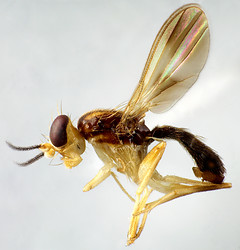Chaetoclusia
Owen Lonsdale and Steve MarshallIntroduction
Dorsal setulae on vein R1 most readily characterizes Chaetoclusia Coquillett, a small neotropical genus of 13 species that is most diverse in Central America and the Caribbean (Lonsdale & Marshall in press). Its type species, C. bakeri Coquillett, is widespread in the tropical Neotropics outside of the Caribbean, and is the only species likely to be encountered with any frequency; it is quite easily identified, being the only species in the genus with a densely plumose arista.
Characteristics
Chaetoclusia is defined on the basis of setulae on vein R1, the reduction or absence of the anterior lateral scutellar bristle (larger in Chaetoclusia richardfreyi (So?s); independently evolved in other Clusiidae), and the reduction of sternites 6 and 7 of the annulus ventrally into a thin, but well-sclerotized band (Lonsdale & Marshall in press). Black bristles are also synapomorphic of Chaetoclusia, but they are retained in only the most ancestral species. Non-synapomorphic diagnostic characters include a shiny gena (pilose or tomentose in most Sobarocephala), two postsutural dorsocentral bristles, no presutural intra-alar bristle, a dorsal preapical bristle on the mid tibia, and a closed cell bm (open in most other Sobarocephalinae).
Phylogenetics
Chaetoclusia has been revised by Lonsdale & Marshall (in press), providing a phylogenetic analysis and a key to all species. Chaetoclusia is the sister group to the clade containing Sobarocephala + Procerosoma, defined by an open cell bm, no presutural intra-alar bristle (also found in the Clusiodinae), and a small pregonite. These three genera comprise the subfamily Sobarocephalinae, characterized by loss of the male sixth spiracle (otherwise left lateral on the annulus), a ventral lobe of the hypandrium that is usually at least as long as the hypandrial arm (secondarily reduced in several species of Chaetoclusia and Sobarocephala), and a relatively large surstylus.
References
Lonsdale, O & Marshall, S.A. In press, a. Redefinition of the Clusiinae and Clusiodinae, description of the new subfamily Sobarocephalinae, revision of the genus Chaetoclusia and a description of Procerosoma gen. nov. (Diptera: Clusiidae). European Journal of Entomology.
Title Illustrations
| Scientific Name | Chaetoclusia bakeri Coquillett, 1904 |
|---|---|
| Location | Neotropics |
| Specimen Condition | Dead Specimen |
| Sex | Male |
| Copyright | © Steve Marshall |
About This Page
Owen Lonsdale
Insect Systematics Lab
Department of Environmental Biology
University of Guelph
Guelph, ON
N1G 2W1
Canada
Steve Marshall
Insect Systematics Lab
Department of Environmental Biology
University of Guelph
Guelph, ON
N1G 2W1
Canada
Correspondence regarding this page should be directed to Owen Lonsdale at and Steve Marshall at
Page copyright © 2005 Owen Lonsdale and Steve Marshall
- First online 25 August 2005
Citing this page:
Lonsdale, Owen and Marshall, Steve. 2005. Chaetoclusia. Version 25 August 2005 (under construction). http://tolweb.org/Chaetoclusia/27679/2005.08.25 in The Tree of Life Web Project, http://tolweb.org/








